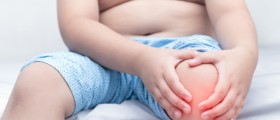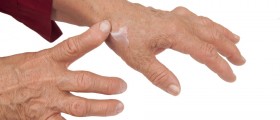
Juvenile rheumatoid arthritis, also known as Still's disease, is a type of arthritis (inflammation of joints) affecting only children. Once it occurs the condition becomes chronic even though there are cases when children can completely recover with no recurrent inflammation.
Causes
The underlying cause of juvenile rheumatoid arthritis is still unknown. Medical experts believe that the condition is a result of abnormal body's reaction. Namely, the body produces autoantibodies which attack and destroy certain body tissues, in this case various joints.
In the majority of cases juvenile rheumatoid arthritis affects children after they turn 16. However, there have been cases of the disease affecting even much smaller children, for instance infants who were 6 months old.
As for classification, juvenile rheumatoid arthritis is divided into systemic disease, polyarticular juvenile rheumatoid arthritis and pauciarticular rheumatoid arthritis. Systemic form of the disease apart from joints affects the entire body and is characterized by pain and fever. Skin rash may occur as well. In polyarticular juvenile rheumatoid arthritis many joints are affected. This condition may easily progress into rheumatoid arthritis. Unlike polyarticular form of the disease when more than 5 joints are affected in patients suffering from pauciarticular juvenile rheumatoid arthritis the inflammatory process is localized to only 4 or fewer joints.
It is essential to mention that juvenile rheumatoid arthritis may run in families although this is not always the case. Finally, certain environmental factors may play additional role in the onset of the disease.
Symptoms and Signs
Symptoms of the condition are not unique and vary among children. The child, for instance, may experience severe joint pain which makes him/her limp. Swelling of the affected joints is almost always present along with stiffness which is basically the most prominent in the morning upon waking up. The symptoms come and go, range from mild to severe and may reoccur within the period of even several years.
Inflammatory process affecting the joints makes them more rigid and less movable. The skin above the inflamed joint is warm to touch and many times red. In case of systemic juvenile rheumatoid arthritis, the child additionally develops fever, skin rash and sometimes his/her lymph glands enlarge. It is also possible for patients to face eye issues like uveitis, iridocyclitis and/or iritis. In such case the eyes become red, painful. Vision changes and photophobia occurs as well.
Diagnosis
Doctors routinely take patient's history and perform a physical exam. While examining the affected joints they may easily feel the warmth of the skin, notice the redness, swelling and reduced mobility. Further examination may reveal additional issues like swelling of the liver or spleen and regional lymph nodes.
Furthermore, patients undergo routine as well as specific blood test. It is essential to estimate the level of certain substances in the blood which may easily point to the presence of juvenile rheumatoid arthritis. This is why the tests evaluate the presence and the amount of rheumatoid factor, ANA etc. Complete blood count and erythrocyte sedimentation rate are of additional help. Finally, genetic testing may reveal HLA antigens for HLA B27. However, in spite of the condition being active and bothering patients, the aforementioned test may not show any abnormality.
If this is the case, further investigations include taking samples of fluid from the swollen joint, X-ray of the joint, bone scan and eye exam (only if there are symptoms and signs affecting the eyes).
Treatment
In patients in whom only small number of joints are inflamed, NSAIDs are the best treatment option. Ibuprofen, naproxen and other members of this group of anti-inflammatory drugs are highly efficient against juvenile rheumatoid arthritis.
Severe forms of the disease require more potent anti-inflammatory drugs like corticosteroids. These drugs are administered only when necessary and under thorough supervision because of many adverse effects, most of which are highly detrimental for children.
DMARDs or disease-modifying antirheumatic drugs are a good option for children in whom there are additional systemic symptoms and signs like fever or skin rash and swelling of lymph nodes. This group of medications includes methotrexate and biologic drugs (e.g. etanercept, infiximab etc.).
The goal of the therapy is to preserve mobility of the affected joints. This can be easily achieved with exercises. The exercise plan is best created by a well experienced physical therapist. Apart from exercise program such children should engage in other physical activities like walking, bicycling or swimming. Prior to any kind of physical activity, the child must warm up first.
Many parents fear of the potential necessity of surgery. However, surgery is practically never an option and is rarely recommended treatment approach in children suffering from juvenile rheumatoid arthritis. It is engaged only if the affected joints have been severely deformed or damaged to the extent when they simply must be replaced.
Finally, all children are advised to stay active as much as possible and not to fear of their illness because with proper treatment, juvenile rheumatoid arthritis is easily brought under control.

















Your thoughts on this
Loading...